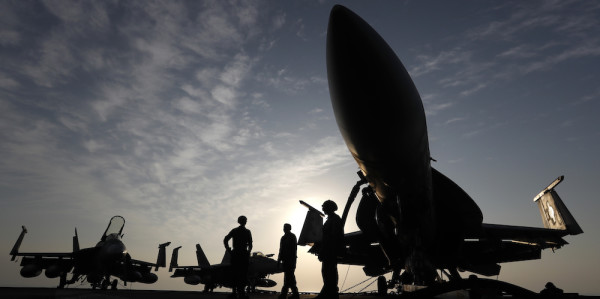

The Pentagon is presenting options for a broader military intervention in Syria to White House officials, including Secretary of Defense James Mattis and National Security Adviser H.R. McMaster, U.S. officials said on Thursday.
The news came hours after Reuters reported that officials were considering military action after Syrian government forces loyal to President Bashar al-Assad reportedly carried out a chemical attack targeting the village of Khan Shaykhun in the war-torn country’s northern Idlib governorate. The Washington Post has more details:
The Pentagon is in the process of presenting options to the White House on potential military responses, which could include strikes on Syrian military targets and actions designed to ground the Syrian air force.
Some officials urged immediate action, warning against what one described as “paralysis through analysis.” But others were concerned about second- and third-order effects, including the response of Russia, which also has installed sophisticated air-defense systems in Syria
Speaking at a Thursday news conference from Palm Beach, Florida, Secretary of State Rex Tillerson said that the US is considering the “appropriate response” to the Syrian government’s use of chemical weapons, emphasizing that he see “no role” for Assad in shaping the country.
“The process by which Assad would leave is something that requires an international community effort both to first defeat ISIS within Syria, to stabilize the Syrian country to avoid further civil war and then to work collectively with our partners around the world through a political process that would lead to Assad leaving,” said Tillerson. “Assad’s role in the future is uncertain clearly, and with the acts that he has taken it would seem that there would be no role for him to govern the Syrian people.”
Nearly 80 people, including women and children, were killed by a nerve agent eyewitnesses claim “was dropped from warplanes,” according to the Guardian. In a statement on Thursday, the Turkish Health Ministry said preliminary tests had confirmed the toxic gas was likely sarin.
The production, stockpiling, and use of sarin gas was banned by international law under the 1997 UN Chemical Weapons Convention. In 2013, two rebel-controlled positions in the Damascus suburb of Ghouta were struck by sarin-filled rockets launched by government forces, killing nearly 281 people.
In the aftermath of the 2013 chemical attack, then-President Barack Obama asserted that Syria had crossed the “red line” and announced his intent to seek authorization for the use of American military forces to intervene in Syria, an intervention averted after the Syrian government agreed to a joint U.S.-Russian effort to destroy the country’s chemical weapons stockpile.
The U.S. military has been active in Syria since, mainly leading the multinational coalition to beat back the spread of ISIS militants across the Middle East. And in recent months, the Trump administration has deployed the 75th Ranger Regiment and the 11th Marine Expeditionary Unit, howitzers in tow, to bring the pain to the terrorist group.
But as gruesome images from Tuesday’s chemical attack crisscrossed the globe, Trump decried the attack as a “heinous” act that “cannot be ignored by the civilized world,” blaming his predecessor for not going far enough to bring the Syria’s bloody six-year civil war to a close.
“These heinous actions by the Bashar al-Assad regime are a consequence of the past administration’s weakness and irresolution,” Trump said in a statement. “President Obama said in 2012 that he would establish a ‘red line’ against the use of chemical weapons and then did nothing. The United States stands with our allies across the globe to condemn this intolerable attack.”
According to Reuters, Mattis plans on presenting the options worked out in “detailed discussions” between the Pentagon and White House to Trump while he works from his Mar-a-Lago home in Florida. Knowing the president, the nation will know what comes next for U.S. involvement in Syria sooner rather than later.
